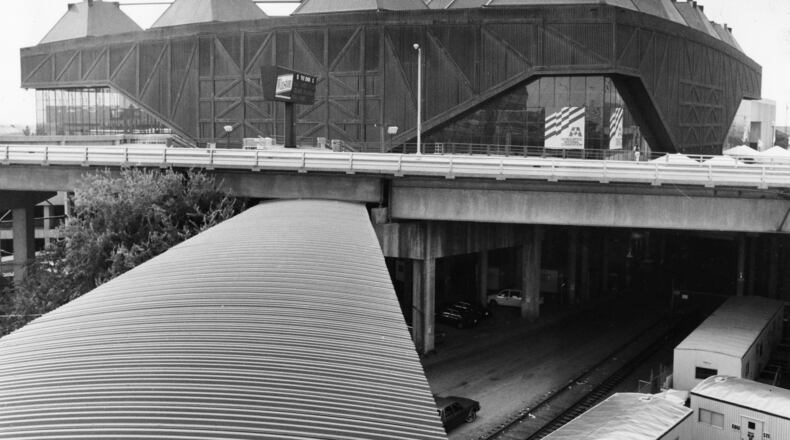Editor’s note: This story was originally published on July 19, 1987
The neon light sculpture glows again on Marietta Street, and inside CNN Center, formerly Omni International, the blue-green laser sculpture, replica of the “Great Dog” constellation, beams over the atrium.
(Rumor has it the constellation sculpture denotes Omni developer Thomas G. Cousins’ loyalty to the Georgia Bulldogs.)
Credit: AJC Staff
Credit: AJC Staff
On the long-vacant six balconies inside CNN Center, red camera lights gleam in the studios of Cable News Network (CNN) and CNN Headline News.
On the complex’s main level, once dominated by an ice rink, the chill is gone. Brightly colored umbrellas shelter tables of new restaurants; gushing fountains and lush plants provide a restful backdrop.
But the essential ingredient of the new ambiance at the complex is not its trappings, but its inhabitants.
A work force of 3,000 toils at the 11-year-old development, perhaps Atlanta’s most noted real estate debacle, now transformed into the vibrant corporate headquarters of Turner Broadcasting System Inc.
The conversion was completed last week when the studios, the last operation to be moved from TBS’s Techwood Drive location, went on the air at the downtown complex.
Credit: AJC
Credit: AJC
On Aug. 1, daily public tours of the studios will begin, enhancing the center’s status as a tourist attraction.
The repopulation of the center, developed by Atlanta’s Cousins Properties Inc., is expected to continue as prospective office and retail tenants, who awaited the completion of the Turner relocation, make their move.
While TBS’s goal of convincing other media operations to locate in the complex, making it a media center, “is not working out yet,” it has a better chance now that CNN has completed its move and prospective tenants can see this “is for real,” according to Don MacConaugha, general manager of CNN Center.
Atlanta’s landing of the 1988 National Democratic Convention at the Georgia World Congress Center is a boon for the complex, which is next door, said MacConaugha. “For us, it’s not just four days; it’s a year,” he said, adding that while some convention-related operations want to lease space short-term, others want quarters for up to a year.
“Interest will snowball until the convention,” he said. “From a marketing, leasing and recognition standpoint, the convention will have a long-term impact on CNN Center.”
Acquisition of the complex by TBS “gives us a reason for being,” said Reggie Mitchell, a consultant in the pre-construction phase of Omni International who has operated Reggie’s Pub there since 1976.
TBS not only becomes the complex’s first anchor tenant, but the strong Turner presence — most visible in the operation of the glass-enclosed studios, designated by a green neon CNN logo — creates a focus that Omni International lacked.
The original components of the Omni concept “tried to span the spectrum but was “too broad a focus,” according to Thomas Ventulett, partner in the architectural firm Thompson Ventulett and Stainback that designed the innovative urban structure and has been a tenant since it opened.
There was an ice rink to draw children and families. There also were two office towers, high-style retailers for affluent shoppers, fine restaurants for well-heeled diners, and movie theaters.
Credit: AJC file
Credit: AJC file
The drawback, said Ventulett, was that they did not necessarily complement one another; in fact, some negatively impacted one another.
For instance, he said, the ice rink, a fad with developers in the early 1970s, “didn’t bring in the people who could support the other uses.”
The target market was not only too broad, it was in a state of flux not only in the design phase but even after construction started.
The balconies that became the World of Sid and Marty Krofft, an indoor amusement park, were “originally thought of as an international trade mart . . . called the trade pavilion,” he recalled. “It was under construction when it was decided to change to Krofft. There was a lot of jumping through hoops to make it fit that design.”
“Most challenging to everybody was trying to put the office and hotel on the market . . . (with the project) continuing to change while it was under construction,” Ventulett said. “The hotel started out as a business and sports enthusiast type (to play off of the then-new adjacent sports arena), changed to luxury and then to convention . . . so the ballroom ended up across the street (connected to the main structure by an enclosed bridge).”
“It was an incredible experience,”he said.
The Krofft attraction shut its doors six months after it opened.
Credit: AJC
Credit: AJC
Another entertainment-related use was proposed for the balconies in 1981 when the now-defunct Atlanta-based International Picture Show Co. proposed installing movie studios in the Krofft space as a public attraction.
Subsequently, in 1983, Cousins Properties set in motion a plan to convert the balcony space along with the office towers and atrium to a technology mart. That venture was dropped in 1984, however, in the face of competition from developer John Portman, who unveiled a plan for adding a large computer mart at Peachtree Center.
The occupancy problems of Omni International stemmed not only from the several strategies that fizzled, but also from the pullout of two large office space users, Coca-Cola Co. and Georgia Power Co., who relocated to their new corporate buildings.
The 600,000 square feet of office space contained in the two towers is now 80 percent occupied, with Turner operations in 220,000 square feet of it, and half the 200,000 square feet of retail space is leased.
TBS’s renovation program, including a new street-level entrance to the complex, a new hotel entrance onto the atrium and a complete renovation of the hotel, will drag on for several months, said MacConaugha.
While access to the complex is being improved, architect Ventulett said, “the biggest drawback (remaining) is the concrete walls along the street - designed like a shopping center with all the shops opening onto the atrium.”
Credit: AP
Credit: AP
The updated version of the complex has attracted new retailers and led some existing tenants to expand. Reggie’s, for instance, is expanding with a dining area in the atrium. Two new restaurants, the Lion’s Den and Cafe de Sol, opened with dining areas on the atrium.
But in some instances, new ventures are slow. The movie theaters, which were part of the original complex and closed three years ago, have been reopened, but admittedly are drawing few patrons. TBS could find no operator willing to lease the theaters because of its requirement that one theater run classic movies and another “Gone With the Wind,” and instead pays UA Communications/Georgia Theater Co. a management fee to run the operation.
Establishment of the Grammy Hall of Fame in 40,000-square-foot quarters beside the main entrance to CNN Center is bogged down in financial and legal issues related to its bond financing.
While the complex has attracted ample food service tenants, MacConaugha said, “We need things like a dry cleaner, florist, bookstore and office supply store.”
The complex has become an $85 million venture for TBS. The company first acquired 75 percent of the ownership in the 1.3 million-square-foot complex in 1985 by paying $1.75 million in cash and assuming $64 million in loans from the Canadian Imperial Bank of Commerce. That loan included the renovation funds.
In August 1986, TBS bought the remaining 25 percent from Cousins Properties with $10 million in cash and a $10 million note.
The original construction loans for Omni International amounted to $76 million. The project, whose opening coincided with the mid-1970s recession, never obtained permanent financing. In 1978, lenders, led by Morgan Guaranty, twice threatened foreclosure, but subsequently granted Cousins Properties a reprieve until January 1981.
At easing of the financial pressure, Cousins Properties in 1979 proposed an ambitious second phase for the complex that would be much larger than the first.
Named Omnisouth, it was to be $265 million, 22-acre project stretching from the Omni to Rich’s downtown department store. Federal grants were sought to help finance the venture, which was to include a $39 million space needle.
Omnisouth was designed to be an urban retail center complete with department stores, said Ventulett, who added that for Omni International, “it is hard to be an urban retail center without department stores.”
Omnisouth was proposed, he said, as “an exploration to see if it could be done, but the market analysis was not strong enough; retail was weakest.”
Omni International originally was envisioned by Tom Cousins as a step toward extending high-rise development from Techwood Drive to the Five Points MARTA station. The development is located in railroad air rights leased from the state of Georgia as part of a 20-acre assemblage begun more than 25 years ago.
The Omnisouth project never got off the drawing boards, and during the year preceding the lenders’ January 1981 deadline, Omni International spent more than $1 million on a series of special events aimed at drawing people to the Omni and spiffing up its image for prospective investors.
By the lenders’ deadline in January 1981, unpaid interest had swelled the debt to $110 million, and the banks accepted 50 cents on the dollar. Funding for that transaction was provided by Daon Corp., a large Canadian developer, which became a half-owner of Omni International with Cousins Properties, and arranged financing from the Canadian Imperial Bank of Commerce. Daon’s financial condition worsened a short time later, and money for a $20 million renovation of the complex, which would have converted part of the office space to hotel rooms, never materialized.
“There were some depressing times for us, having been the architects here,” recalled Ventulett. “The project was beginning to have an ambiance that was not as positive as we would like to be part of.”
The negatives plaguing the sparsely populated complex included crime - mostly muggings and purse-snatchings, but including one highly publicized murder. A TBS spokesman said that has been largely overcome.
Relocating a police precinct from quarters four floors below to a prominent spot on the main retail level has “really done wonders to make people feel safe,” said a TBS spokesman.
It is not just a matter of perception, according to Steven Funk, TBS vice president of administration. “The number of ‘incidents’ is down 70 percent from 1985,” he said.
In addition to the highly visible presence of police at the complex, it is also patrolled by Turner Security Inc., a firm that is an outgrowth of stadium security operations for the Atlanta Braves.
As to recurring rumors that the complex is once again on the market, Funk said, “We are not looking to sell this complex.” The rumors persist, he said, because “about once a month some broker calls and says he has got a buyer, and we say it is not on the market.”
A phenomenal offer would have to be considered, but none has been forthcoming, he said. “This is a good investment,” he added. “We feel it has more appreciating to do before we would consider selling it . . . and if we did anything, it would be a sale and lease-back.”
About the Author
Keep Reading
The Latest
Featured





